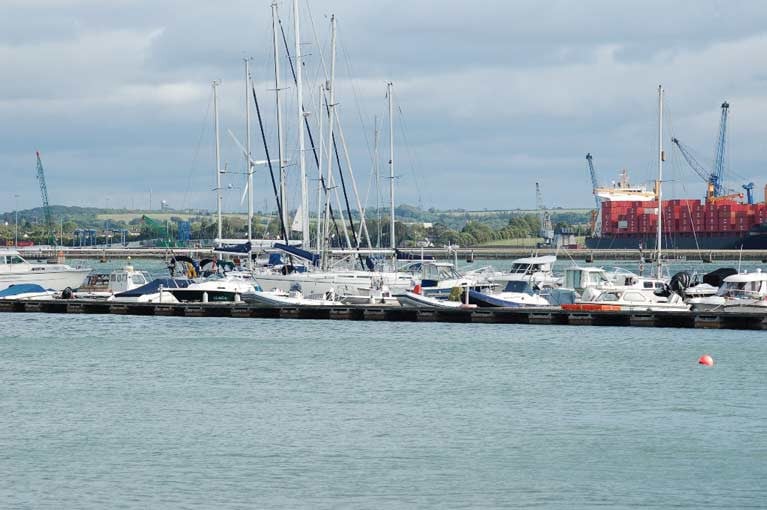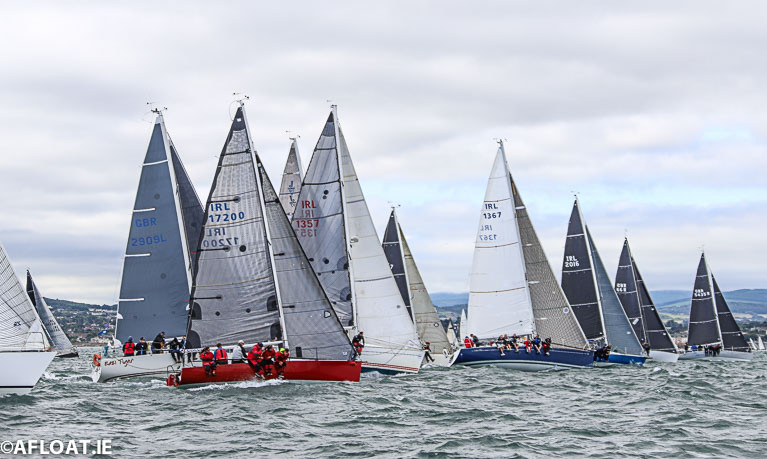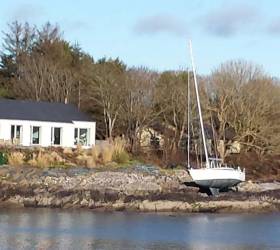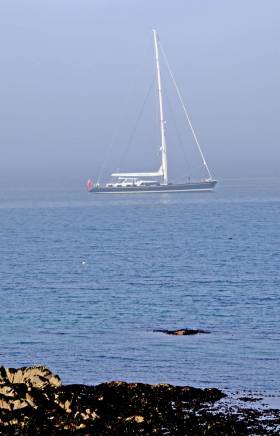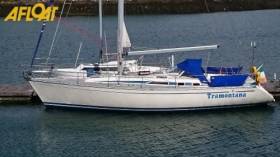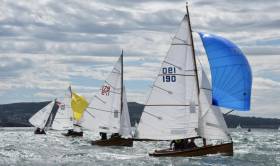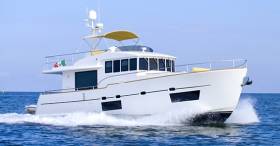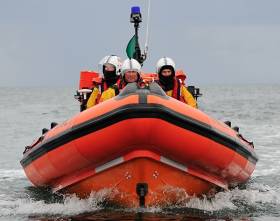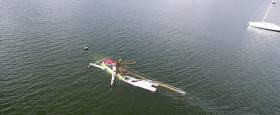Displaying items by tag: yacht
Kinsale yachtsman Alan Mulcahy's recently arrived First Class 8 'Black Magic' yacht has been lost after a fire on board the boat at the weekend.
The yacht went up in flames and sank off Ringabella, just outside Cork Harbour on Monday afternoon during a scheduled delivery trip back to Mulcahy's home port of Kinsale Harbour in West Cork.
The dramatic scene was witnessed by nearby boats and people on the shoreline.
 The smoke plume clearly visible from the shore. See videos below
The smoke plume clearly visible from the shore. See videos below
The yacht had competed in October's recent AIB Royal Cork Yacht Club Autumn Series and this month's O'Leary Insurances Winter League and was due to be lifted out and stored ashore for the winter at Kinsale Boatyard.
 Black Magic on fire following a problem with the outboard engine. Photo: courtesy Cian O'Connor
Black Magic on fire following a problem with the outboard engine. Photo: courtesy Cian O'Connor
Mulcahy, the only person onboard the boat at the time of the incident, told Afloat that he was approximately an hour into his trip when he heard a bang and saw the vessel's outboard engine on fire.
Mulcahy, who is a very experienced sailor with over 30 years experience and Yachtmaster certification, put out a mayday call via his VHF radio that was answered by a nearby trawler who relayed the message to the Coastguard.
Mulcahy said he made his way to the bow of the boat as flames engulfed the cockpit area.
Fortunately, a nearby 20-foot opening fishing boat, the Annabella, skippered by Mick Hoey and crewed by Cian O'Connor, saw the flames and rescued Mulcahy from the burning fibreglass vessel.
 Alan Mulcahy's recently arrived First Class 8 'Black Magic' that went on fire and sank off the Cork coast Photo: Bob Bateman
Alan Mulcahy's recently arrived First Class 8 'Black Magic' that went on fire and sank off the Cork coast Photo: Bob Bateman
Mulcahy said that the yacht sank shortly afterwards. He was then transferred from the Annabella and taken ashore to Crosshaven by a Port of Cork RIB skipped by Kieran Coniry.
Mulcahy expressed his deep gratitude to all involved in the rescue including the Coastguard, the fishermen on board Annabella, the Port of Cork RIB crew and Gary Heslin of the Crosshaven RNLI and the staff and doctors who then assessed him for smoke and fire inhalation.
It is the second incident to befall racing yachts at Cork Harbour this winter, with a J109 ending up on the rocks in the last race of the Royal Cork league as Afloat reported here.
• Fisherman Mick Hoey spoke to Joe Duffy on RTE Radio One about how he and crewman Cian saved Yachtsman Alan Mulcahy here
I'd Like to Go Yacht Racing This Season - But...
The sight of more masts appearing on the marina in my village of Monkstown on the edge of Cork Harbour was encouraging this week. Not that I have any disregard for the motorboat community who populate the Cork Harbour Marina year-round, but in this difficult and challenging season, it was good to see more yacht masts in the marina and other yachts going onto their moorings in Monkstown Bay.
That was the good news. The disappointing news was from Sail Training Ireland that they have had to cancel all Tall Ship voyages planned for this year.
Chief Executive Daragh Sheridan said this was inevitable because there was no way the organisation “could ensure the social distancing required to ensure the safety of trainees and crew.”
That is the issue which troubles me about the resumption of cruiser yacht racing.
The Government’s medical advisors and the Minister for Health have been making it clear that, as Mr.Harris has said: “social distancing will be with us for a long time.”
How can social distancing be achieved on a racing yacht?
Two metres is just over six feet, even one metre would be difficult, “impossible” is the description I’ve heard repeatedly in phone calls and read in Emails.
Two instances this week highlighted my thoughts about this “social” or “physical distancing.” One was when I was reminded of a 30-year anniversary and the lack of any “social distance” on my only TransAtlantic race, back in May 1990 as a crew member aboard NCB Ireland on the last leg of that year’s Round the World Race, then known as the Whitbread, from Fort Lauderdale to Southampton - 3,818 nautical miles sailed over 18 days. The crew shared “hot bunking”. Mine was the middle of three where when lying down there wasn’t enough space to raise a book to read.
Social or physical distancing wasn’t possible on the 83-foot NCB and I can’t see it either on Scribbler, the 33-foot Sigma which I sail with my son, grandsons and occasional other crew. We won’t even qualify as a family crew because we are in two households.
 Yacht Racing at the 2019 Volvo Dun Laoghaire Regatta Photo: Afloat
Yacht Racing at the 2019 Volvo Dun Laoghaire Regatta Photo: Afloat
Irish Sailing are doing their best, but there seems little official understanding of the requirements of sailing. How do you keep apart during the demands of racing, when more than one person may be needed to get a sail in or to launch and recover a spinnaker, or what about adding weight on the rail?
Solo racing will be ok, but there aren’t a preponderance of single-household cruiser racing crews, or so it appears from the reaction I’m receiving. Even with the easing of restrictions, the constant message is that social distancing stays in place…. So can cruiser racing be resumed?
All the comments I’m getting seem to be doubtful unless there are major changes in social distancing. I hope there are because I’d like to go sailing and racing this season.
This week’s Podcast is below...
The Joys & Language of Yacht Racing
What is the most important, challenging and decisive part of yacht racing?
“The start of the race.”
That was what experienced skippers and crews told me - on the start line a race could be won and lost.
So, when I ‘stepped up’ from dinghy racing and what was described to me by the “cruiser class” as “the wet ass brigade” I was well aware of start line importance.
But I found there was one major difference - Language and the force and manner of its expression!
My introduction to this was in my first race in my first cruiser, my first ‘Scribbler’ – a Ruffian 23. Two weeks after I bought her and two days after launching, she was on the start line for the National Quarter Ton Championships raced out of the Royal Cork YC at Crosshaven. It was a heavy weather day, some 30 years ago, so windy that racing was inside Cork Harbour because outside the conditions were too severe.
My experience up to then was of dinghy racing, Mirrors and 12ft. Vagabonds in Monkstown Bay and National 18 crewing. Scribbler’s crew was me on the helm, with my young son and his friend. On the start line over 20 yachts of various sizes and design circled each other in what was then the 10-5-minutes start sequence. Helming 23-feet amongst them was a bit different from 12-foot dinghies as they prowled each other.
When the start gun went they all charged for the same part of the line – as close as they could get to the stern of the committee boat, with roaring and shouting erupting.
Some epithets I never thought I’d hear from the refinements of the RCYC which I had joined only shortly before entering the Championships, were uttered. Wow, the language, the shouts of “Up, Up, Up you….!!” Retorts of: “You’ve no ……..rights…” “Get out of there….” (the moderate comment) and more …
How we got across the line without being thumped or banging into another boat I can never remember.
The course was along the edge of the Aghada shoreline, then a nice freeway before the ESB ruined it by turning it into an obstacle course with their waterborne protrusions associated with the onshore power station. We rounded the weather mark and up went kites. In the days before I became more cautious about spinnakers, we hauled too, for a speedy broad reach - then we came to the gybe mark and, well, that didn’t go too well…a series of three photos appeared of Scribbler afterwards captioned – “going, going, gone... The third showed a hand grasping the portside cockpit edge with quite a lot of the hull visible!
Scribbler came upright into the wind and shook herself, possibly wondering about the idiot on the helm. We scrambled to get the kite off, shook ourselves as well, then carried on after the fleet and finished the race.
Back in the clubhouse one of the other skippers approached me, the ‘newbie’ of the fleet and observed that we had shown a fair turn of speed on the reach… “Haven’t had the boat long?” he queried… “Not long,” I agreed.
That was “courageous,” - I like to think that’s the word he used! - “a three-sail reach in those conditions,” he observed. So I asked what he meant and was told: “you had all three sails up, main, jib, spinnaker…”
“Oh,” I replied. “Should I have taken one down…?”
So I learned a bit more about sailing – and about language…
Those thoughts came to mind this week when I heard a man claim on a national current affairs radio programme that a ‘scientific study’ conducted it appeared in just three days, rather a short timespan for scientific study, had revealed that even speaking was dangerous because COVID 19 could be emitted in speech. Sport, he said, might never be possible again for a very long time. Spectators and players would all have to wear masks because: “Can you imagine how dangerous a place it would be with thousands of spectators roaring and shouting at a match?”
Whatever about that scenario, I thought, if speech has to be controlled, it would make sailing so quiet that racing start lines would never be the same again, not to mind crews full of masked individuals.
At least the skipper might be muted!
Listen to the podcast below:
Attempt to Refloat West Cork Yacht This Morning
Attempts to recover a 32–foot that went aground in Schul, West Cork during Storm Ophelia get underway this morning.
A recovery team is expected to slide the yacht down the rocks and back into the water using inflated rubber bags.
€5m Sailing Yacht Anchors in the Fog on Dublin Bay
As soon as the sea fog lifted on Dublin Bay this evening, it revealed a magnificent 112–foot Swan type yacht, Song of the Sea, at anchor in Scotsman's Bay on the south side of the capital's waters.
The sailing yacht with a €5m price–tag can accommodate six guests in three cabins with an interior design by Nautor Swan and an exterior design by German Frers.
The British registered 2002–built navy hulled yacht travelled up the Irish Sea before anchoring just off Dun Laoghaire and moving later into the town marina.
It's the second exotic nautical visitor to Dun Laoghaire this week. On Monday, an exclusive classic motor-yacht at 262–ft long and almost 90–years–old, arrived into the harbour and remains berthed there at St. Michael's Wharf.
Affordable Luxury Yacht On Offer With This Bavaria Lagoon 42
Last week, Boat Sales Blogger was looking at a Rival 41 with proven ocean-going and world-girdling credentials, and an accommodation layout with serious seafaring in mind writes W M Nixon. This week, we look at a boat of broadly similar overall size, yet although this particular vintage of the Bavaria 42 is well able for seagoing and several have crossed oceans, her layout is such that she will give best value when cleverly cruised along beautiful coastlines with comfortable nights berthed in port or at anchor in a snug haven.
As she dates from 1989, she’s from the period when Bavaria’s in-house designer Axel Mohnhaupt was producing relatively hefty craft which weren’t afraid of having that inbuilt level of displacement which brings it own reassuring comfort and seakindliness with it.
Twenty-eight years ago, nearly all the volume boatbuilders were providing craft which were generally heavier than those that they build nowadays. And though the newer boats may please the company accountants, as weight is expensive, while the marketing folk might like to promote the zippier performance which lighter displacement may provide, for a sensible cruising person a bit of weight in the right place makes all the difference to day-in, day-out liveability.
That said, the reason we suggest this boat gives of her cruising best when port is made each night is because the main stateroom is forward. And that stateroom does indeed provide affordable luxury. But it wouldn’t feel at all luxurious when the boat is thrashing to windward out at sea at night, whereas nights in port would have real style to them.
She’s located plumb in the middle of an area where a host of anchorages can be reached with a comfortable day sail, for although Hugh Mockler of Crosshaven Boatyard is the agent, this Bavaria 42 is in Lawrence Cove Marina on Bere Island in Bantry Bay. As Spring begins to creep in, you could have a most enjoyable scenery-laden weekend just going to see her. And with a price of €54,500, there’s more of interest than just spectacular scenery. Then too, she’s a classically handsome boat with it. For although the in-house design team looked after the details, I’ve a feeling she’s of that generation of Bavarias where the hulls were designed by Doug Peterson, no less.
See the full advert here
Howth Yacht Club's Classic Boat Championships Finishes in Style for Mermaids & Howth 17s
The Howth Yacht Club hosted the Classic One-Design Regatta - incorporating the National Championships of the Dublin Bay Mermaid and Howth 17 Footer classes. Download Mermaid results below. Even before you could see them, the vapour of varnish bumbled over the hills and lowlands into Howth. Facebook updates from sailors on motorways passing shiny timber creations confirmed that the Mermaids were officially on tour. Some arrived under cover of darkness and were only noticed early on Thursday morning with a full dinghy pen. Little sailors, just starting out on their sailing careers, couldn't even see over the gunwhales of these big dinghies. They oohed and ahhed at boats made from "actual timber?"
Twenty-three Mermaids were weighed and plopped into Howth Harbour. Some of them had been here relatively recently (1953!) and wondered who had stolen Howth Sailing Club. HYC's Jedi, Neville Maguire was on hand with fellow Mermaid aficionados Gerry and Ian Sargent to poke and point and raise eyebrows at things called "Cleats".
Under the care of National Race Officer Scorie Walls, Thursday's racing started at a polite 1400. Keeping the Northside flag held high, "Azeezy" from Skerries did the business with two wins from three races. Not content with competing with eachother on the water, the Annual Mermaid Table Quiz followed rehydration. In a show of poor manners, a table made up almost entirely of Howth 17 Footers won. A prize was awarded for the best answer to "What is the capital of Mongolia?" "Don't know, but it's got a lot of vowels and sounds fierce foreign".
Two races for the Mermaids on Friday saw "Wild Wind" (Rush SC) and "Tiller Girl" (National YC) equal "Azeezy"'s daily tot of 6 points. The gap wasn't closing.
Howth history in the making was being mentioned all week before the old ladies of sailing, the Howth 17 Footers, put on their Friday night frocks and took to the water for a single race from the East Pier. For the first time in history, 18 boats were afloat and jockeying for position. The busy start line was made slightly more complex when the class was given a downwind/ spinnaker start in front of the East Pier, with boats gybing and tacking simultaneously as they jockied for position with a minute to go. Almost inevitably for the class, the girls began the bumping and grinding before the start signal and "Oona" went for "Rita" like a jealous girlfriend. "Rita’s” stick-man, Marcus Lynch, found himself with a clip around the ear from "Oona's" bowsprit and was forced to retire with injured planks, cracked frames and a split rudder. Turns out that "Oona" picked the wrong girl to shout at and she broke her bowsprit in the collision. And so the anticipated race with the full compliment of the world's oldest one-design racing keelboats never quite happened. The remaining seventeen boats crossed the line with spinnakers flying and more photographers clicking than at a Justin Bieber underwear collection launch. Head girl was "Deilginis" with "Aura" and "Hera" following in her tracks.
Saturday morning saw the Howth 17 Footers dressing up in their finest gowns and bonnets and gliding like debutants to the dancefloor. "Hera" lifted up her skirt and frightened the girls by winning by over two minutes. The brazen thing. She would have to have her cough softened! "Deilginis" took back control of the crowd in Race 3, trailed by "Gladys" sporting her 2016 Spring/Summer collection.
By the middle of the day, the wind had picked up, gusting over 30kts, and it was become hard for some to keep the bonnets atop. The ladies rolled down the run more like drunken maids than the elegant princesses which left the Harbour. Half of the fleet chose to remove their topsails but not before the paparazzi had caught them on video, in full swing...
The Mermaids were on the far side of the trapezoid course and only crossed the Howth 17s at the leeward mark and short beat to the finish. It was likely that some Mermaid sailors were checking their insurance when they saw the 17s approach! Top Mermaid of the day was "Vee" (Rush SC) with a 1st and 4th. "Wild Wind" and "Tiller Girl" produced some magic to close the gap to leader "Azeezy" but it wasn't to be enough to rein in the eventual Champions.
Back on the Howth 17 course, "Leila" and "Aura" sobered and took the last two races, and "Deilginis" was to take the 2016 title. Class Captain, Tom Houlihan, took the Handicap prize aboard his "Zaida".
As the last of the Howth 17 sailors were plucked from the moorings, the Mermaids had already already been craned out and packed up, setting the scene for a packed balcony in glorious sunshine. Rehydration once more!
170 sailors and their entourages filed into the club dining room to be fed, found, watered, awarded and clapped at. Champion Mermaid sailor Sam Shiels pronounced an epic acceptance speech. His Howth 17 opposite, Luke Massey, countered it with an example of brevity and raised the trophy aloft.
The next Classic One-Design Regatta will be held at Howth Yacht Club over the weekend of 10-12 August 2018.
Cantieri Estensi, the Italian builder of these highly appealing lobster boats and trawlers has launched its 535 Maine. After its presentation at the Düsseldorf boat show, the new model was launched this month and makes its debut at the Cannes Yachting Festival in September.
The company says the new 535 Maine follows in the footsteps of the hugely successful previous model, the 530, of which a total of 35 have been sold (rising to 60 when the 480 and 640 sister models are factored in).
Big side windows illuminate the three cabins below deck, while the new solution devised for the door between the cockpit and the saloon makes it possible to create a single space for even more direct contact with the sea. From a technical standpoint, the partnership with Volvo Penta brings all the benefits of electronics to cruising, while innovative fittings like the pivoting swim platform or the joystick to manoeuvre the yacht from the cockpit make life onboard 535 Maine, the ideal “home on the sea”, an even more comfortable experience.
The partnership signed by Cantieri Estensi and Volvo Penta means that 535 Maine can be fitted with all the latest propulsion and steering technology. The engines used are the familiar D6s, available with two rated power outputs and paired with shaft line transmission systems. Volvo Penta’s new Glass Cockpit screens in the helm station provide control of all navigation and monitoring parameters at the touch of a finger. The bow and stern thrusters can also be interfaced with the electronic control system, allowing the yacht to be manoeuvred simply by moving the joystick.
From a construction standpoint, 535 Maine is infusion laminated for maximum structural rigidity, weight for weight. Like the previous 530, the peculiarity of the hull is its ability to deliver cruising comfort in both displacement and planing modes. The relatively small deadrise (14.5 degrees at the bow) makes it possible to cruise at reduced speed without putting much load on the engines, offering a theoretical range of 1,000 nautical miles at 8-9 knots. The variable geometry of the hull, which has a fin running the entire length of the keel and a chine of up to 50° in the forward section, offers maximum directional stability and a soft impact even on rough sea, for fast cruising at peak speeds of up to 25 knots.
A 140 L/h desalinator and a more powerful 12 Kw generator are also available so that 535 Maine can be used for very long voyages, with all the confidence offered by the yacht’s unusually solid construction and category A type approval.
TECHNICAL SPECIFICATIONS
Overall length 17.00 m
Beam 5.00 m
Fuel tank capacity 2,800 l
Fresh water tank capacity 800 l
Engines 2 x Volvo Penta D6-435
Reverse gear HS80AE
Transmission Shaft line, 12° inclination
Deadrise 14.5°
Maximum speed 25 kn
Cruising speed 14 kn
Maximum passenger capacity 12
CE design category A
Construction Hull, sides and superstructure: vacuum infusion
Design Maurizio Zuccheri Yacht Design
RNLI Crosshaven Take Yacht off Beach in Cork Harbour
Crosshaven RNLI lifeboat launched at 10.53pm last night to a small yacht aground at White Bay on the East side of Cork Harbour.
At the scene, the crew found one person in the water attempting to hold the yacht off the beach in the swell and another person on the beach.
One RNLI crewman swam ashore to assess the situation and attach a towline to the yacht. As the casualties were cold and wet, they were handed into the care of Guileen Coast Guard unit for transportation, while the lifeboat brought the vessel to Crosshaven.
A much-admired ongoing restoration project, which had resulted in the full return to original condition of the classic sloop-rigged 26ft South Coast One Design Pegasus, almost ended in tragedy with an explosion aboard the newly-launched boat on the Galway Bay SC moorings at Rinville near Oranmore at the weekend.
What would have been the boat’s second full season after her restoration ended before it had properly begun. She was rigged and ready to have her sails set, but an attempt to boil a kettle resulted in the gas explosion which blew the deck and cabin off the hull, set the hull on fire, brought the mast down, and sank the boat within one and a half minutes.
Fortunately both sailors on board were wearing lifejackets, and despite their burns and injuries, were able to get to a nearby boat. But while one of them was later released from hospital after treatment for burns, the other has been kept in for observation, though it is thought his injuries are not serious.




























